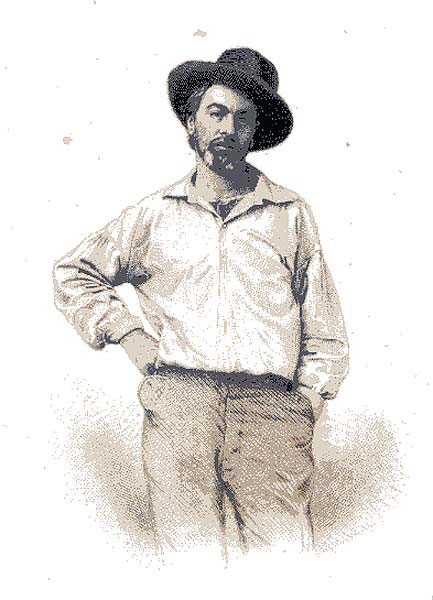 |
Craig White's Literature Courses
(compare formal verse) |
 Walt Whitman (1819-92) engraving from first edition of Leaves of Grass (1855), collection of poetry that "freed verse" (Whitman as a professional printer / journalist self-published this edition.) |
Free verse—lyric poetry that doesn't rhyme or follow regular meter or rhythm, like formal or fixed verse—is so familiar to modern readers and writers that its poetic techniques are often ignored or taken for granted, but recognizing these techniques helps learn . . .
![]() why free
verse is not just prose with broken-up lines
why free
verse is not just prose with broken-up lines
![]() how to tell
good free verse from bad free verse
how to tell
good free verse from bad free verse
![]() poetic
devices (metaphor, symbols,
catalogs, etc.) that may appear in either free or formal verse.
poetic
devices (metaphor, symbols,
catalogs, etc.) that may appear in either free or formal verse.
Essential question: Is free verse still poetry?
The standards of free verse are less evident than those of
fixed or formal verse, but for more than a century
readers have accepted that free verse is a poetic style—in fact the
dominant poetic style or default form used by most major or practicing poets
(though formal verse always survives too).
Free verse by definition operates without metrical lines and end-rhymes, preferring natural rhythms of speech to those imposed by external forms.
If free verse rhymes at all, its rhymes will more likely be internal rhymes or half-rhymes instead of end-rhymes.
Any rhymes in free verse are
meant to seem natural, accidental or opportunistic rather than required or fixed.
Modernist dictum:
Form follows function.
Instead of fixed forms that dictate the shape and language of the poem, free verse follows
the Modernist dictum that form follows function: form
results or rises naturally from the poem’s contents. Instead of an artificial or predetermined pattern,
free
verse ideally adapts to, conforms to, or reflects the thought or impulse
of the poem (mimesis), instead of tailoring the thought to fit the form. In terms
developed by the Romantic poet Coleridge,
poetic form should be
organic rather than
mechanical.
If lyric poems were originally songs that were memorized with the aid of meter and rhyme, what happens to poetry when these musical qualities are lost?
In giving up artificial forms, free verse
sacrifices much of the musical flavor of formal poetry and also
many traditional standards by which poetry is judged successful or
not. When free verse works, however, its pleasures seems to
appear in a wholly new form that it has created on the spot for itself.
What's left when rhythm (meter) and rhyme are lost?
Apart from meter, rhyme, and regular stanzas, free verse may retain many of the other devices that defamiliarize language in such a way that it gains fresh new beauty and meaning:
images and image clusters;
figures of speech including metaphor, anaphora, irony, catalog, and personification;
alliteration and assonance;
graphic elements including spacing, enjambment, and mechanics like punctuation and capitalization (or their absence).
Altogether
free verse should retain and even extend the intensity, strangeness, or
uniqueness of traditional poetry.
Another distinguishing feature of free verse is the stress put on the development of the line.
“The Mighty Line” was a feature of dramatic poetry as far back as Shakespeare, but free verse offers new opportunities for development of this poetic unit. Since free verse has no predetermined length of line, each line must invent itself to meet the needs of the poem and the reader at that unique moment.
An essential outcome is often the aesthetic arrangement of the lines, as in William Carlos Williams’s brief imagistic poem, “This is Just to Say."
Or this excerpt from Williams’s poem, “To Elsie.”
![]()
Historic Background for Free Verse
Free verse was only a matter of time after 1800, when the Romantic poet William Wordsworth in his Preface to Lyrical Ballads wrote, “The principal object, then, proposed in these Poems was to choose incidents and situations from common life, and to relate or describe them, throughout, as far as was possible in a selection of language really used by men . . . ,” and that “the language of Prose may yet be well adapted to Poetry.”
In the following 50 years a number of poets such as
Charles Baudelaire (1821-67) experimented with prose poems rich in metaphor, natural
rhythms, and imagery:
A Port is a delightful
place of rest for a soul weary of life's battles. The vastness of the sky, the
mobile architecture of the clouds, the changing coloration of the sea, the
twinkling of the lights, are a prism marvelously fit to amuse the eyes without
ever tiring them. The slender shapes of the ships with their complicated
rigging, to which the surge lends harmonious oscillations, serve to sustain
within the soul the taste for rhythm and beauty. . . .
Aside
from poets’ inclination to experiment with language, the
greatest factor contributing to the development of free verse was the industrial
expansion of printing presses, which had changed little from the time
of Gutenberg to the time of Benjamin Franklin. In the mid-1800s, however,
presses powered by coal and steam began producing more magazines and
books of all kinds for an increasingly literate population. Just as
most people today think it essential to become computer-literate, people then
were becoming print-literate. Leading the expansion of printing were
best-selling novels by women such as Elizabeth Warner’s
The Wide, Wide World
(1850) and Harriet Beecher Stowe’s
Uncle Tom’s Cabin
(1851-2).
In this historical context appeared a former printer and a newspaper editor who set print for a book of his own free-verse poems that would revolutionize poetry.
On July 4, 1855, in New York City, Walt Whitman
declared the independence of poetry from inherited forms by
self-publishing the first edition of
Leaves of Grass, which he planned to read aloud on
a speaking tour to inspire the common people of the
By the early 20th Century
the great majority of leading American and English poets were writing primarily
in free verse, though Robert Frost would compare the style to “playing
tennis without a net.” In the early 20th century free verse stands as
the default style of serious poetry, though the New Formalist movement has
attempted to re-orient new poets to traditional forms.
Aside from the appearance and form of poetry, the greatest
change wrought by free verse is that, even though it may live in the voices of
its authors or admirers who speak it aloud at poetry readings, free
verse lives on the page and not in the memories of poetry lovers. It’s possible
to memorize free verse, but the uniqueness or quirkiness of its forms and the
absence of rhyme and meter deprive it of the mnemonic devices whereby
earlier generations memorized verse, though we can still sing the words to our
favorite songs.

example of Modernist architecture: "form follows function"
Examples of Free Verse
e e cummings, "[who's most afraid of death?]"
William Carlos Williams, "This is Just to Say"